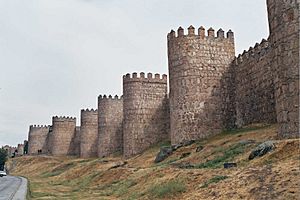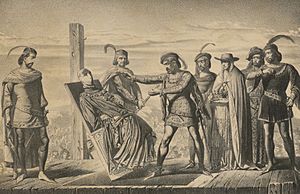Farce of Ávila facts for kids
The Farce of Ávila was a very unusual event that took place near Ávila, Spain, on June 5, 1465. During this event, a group of powerful noblemen from the Kingdom of Castile pretended to remove their king, Henry IV of Castile, from power. They did this by using a wooden statue of him! After "deposing" the statue, they announced that Henry's younger half-brother, Prince Alfonso, who was only 11 years old, was the new king. People who didn't support this event called it the Farce of Ávila because it seemed like a joke or a play.
Why the Nobles Were Unhappy
During the time King Henry IV ruled, different groups of noble families were constantly fighting. They wanted more power for themselves and often went against the king. A very powerful nobleman, the Marquis of Villena, was upset. He felt that King Henry was giving too much special treatment to his rivals, like the Mendoza family and the king's close friend, Beltrán de la Cueva.
Because of this, the Marquis of Villena formed a strong group against the king. This group included important church leaders, like the archbishops of Toledo, Seville, and Santiago. Other powerful families, like the house of Enríquez, and counts such as Plasencia and Alba, also joined this alliance.
In December 1464, this group of nobles gave King Henry an ultimatum. They told him that if he didn't change his ways and get rid of his current advisors, they would remove him from the throne. King Henry tried to talk things over, but they couldn't agree. So, the nobles went ahead with their plan. They first declared him no longer king in Plasencia in April 1465, and then held the famous ceremony in Ávila in June.
What Happened at the Ceremony

The noblemen set up a large wooden platform that everyone could see from far away. On this platform, they placed a wooden statue that looked like King Henry. The statue was dressed in sad-looking clothes and had a crown, a staff, and a sword. These items were symbols of the king's power.
Many important people were there, including the Archbishop of Toledo, the Marquis of Villena, the Count of Plasencia, and the Count of Benavente. Many ordinary people from the town also came to watch. Prince Alfonso, who was not quite eleven years old, was also present.
First, a religious service was held. After it finished, the rebels went to the stage. They read a long list of complaints against King Henry IV. They accused him of being too friendly with people of different faiths. Most seriously, they claimed that his daughter, Princess Joanna, was not truly his own child. If this were true, it would mean she could not legally inherit the throne.
After they finished reading their complaints, the Archbishop of Toledo stepped forward. He removed the crown from the wooden statue, which symbolized taking away the king's royal power. Then, the Count of Plasencia took the sword, which represented the king's role in giving justice. Finally, the Count of Benavente took the staff, which symbolized the king's power to govern.
After removing these symbols, they brought Prince Alfonso to the platform. They loudly declared him the new king, shouting, "Castile, by King Alfonso!" Then, people came forward to show their loyalty to the new young king by kissing his hand.
What Happened Next
The new King Alfonso XII was very young, and many people believed he was mostly controlled by the Marquis of Villena. Most of the country did not accept Alfonso as king and remained loyal to Henry IV. This disagreement led to many fights and unrest across the kingdom.
The situation remained difficult until Alfonso died in 1468. After his death, his sister, Isabella, eventually accepted King Henry IV's authority. However, during the three years after the ceremony in Ávila, Alfonso did act as king. He even had his own royal court, which was a lively place for culture. Many important noblemen, writers, and artists were part of his court. These included poets like Diego Gómez Manrique and his nephew Jorge Manrique, a lawyer named Nicolás de Guevara, and the historian Diego de Valera.
Diego Gómez Manrique was known for organizing fun events and writing plays for the court, especially to celebrate the young king's birthday. In these plays, ladies of the court would even dress up as fairies! One of the most famous poets from this time was Jorge Manrique, known for his "Verses on the death of his father."
Later, the Marquis of Villena and some of his allies changed their minds and broke away from Isabella. When King Henry died in 1474, they supported Princess Juana as the rightful heir to the throne. However, many people who had been part of Alfonso XII's court decided to support Isabella instead, and they did very well under her rule. This disagreement led to a big conflict called the War of the Castilian Succession, which lasted until 1479.
See also
 In Spanish: Farsa de Ávila para niños
In Spanish: Farsa de Ávila para niños


